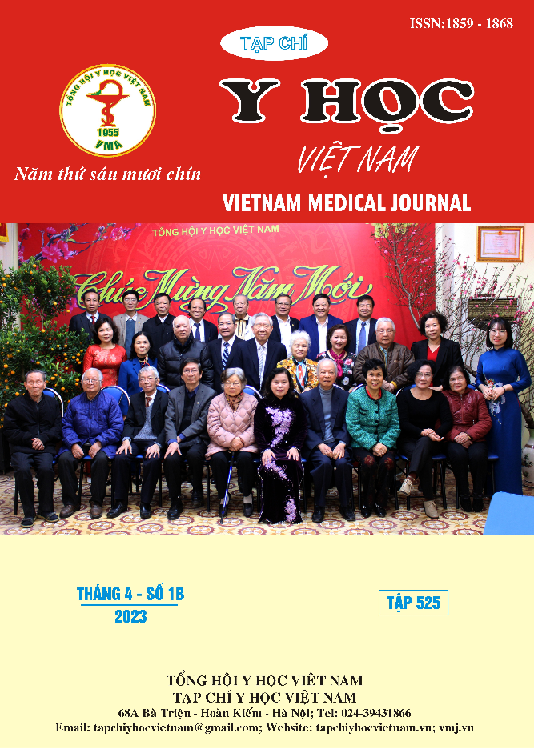DIAGNOSTIC YIELD OF JNET CLASSIFICATION FOR PREDICTING OF COLORECTAL POLYP HISTOPATHOLOGY
Main Article Content
Abstract
Introduction: Colorectal polyps are closely related to colorectal cancer. The JNET classification with magnified narrow-banding imaging (NBI) aids in predicting the histology of colorectal polyps, thus allowing for the appropriate treatment. However, the diagnostic yield of JNET classification on NBI mode with dual focus (DF) magnification in predicting the histology of colorectal polyps is still under-researched in Vietnam. Objective: To determine the diagnostic stratification ability of JNET classification on NBI-DF mode in predicting the histology of colorectal polyps. Methods: A cross-sectional descriptive study was conducted on 666 patients with 1087 colorectal adenomatous polyps from October 2021 to February 2023 at the University Medical Center. Data were analyzed using SPSS 25.0 software. The EVIS EXERA III CV-190 processing system and CF-HQ190I endoscope were used to evaluate the polyps according to JNET classification. Results: The sensitivity, specificity, positive predictive value, negative predictive value, and accuracy of the JNET classification types for predicting the histology of colorectal adenomatous polyps were as follows: type 1, 86.5%, 95.7%, 88.3%, 95.0%, and 93.2%; type 2A, 91.9%, 81.4%, 90%, 84%, and 87.7%; type 2B, 54.7%, 96.6%, 54.7%, 96.6%, and 93.7%; type 3, 66.7%, 99.9%, 93.3%, 99.4%, and 99.4%. The sensitivity for differentiating neoplastic lesions from benign non-neoplasia lesions was 97.8%, the specificity for distinguishing malignant neoplasia from benign neoplasia was 95.9%, and the specificity in the differentiation deep submucosal cancer from other neoplasia was 99,8%. Conclusion: JNET classification based on NBI-DF has a high value in predicting the histology of colorectal polyps. Thus, JNET might contribute to appropriate treatment choices and avoid unnecessary surgery. This classification should be utilized in the Vietnamese setting.
Article Details
Keywords
Colorectal polyp, Japan Narrow Banding Imaging Expert Team; Narrow-banding, dual focus, Vietnam
References
2. Vũ Việt Sơn. Khảo sát phân loại polyp đại trực tràng bằng phương pháp nội soi phóng đại nhuộm màu ảo [Luận văn thạc sĩ Y học]: Đại học Y Hà Nội; 2018.
3. Komeda Y, Kashida H, Sakurai T, Asakuma Y, Tribonias G, Nagai T, et al. Magnifying Narrow Band Imaging (NBI) for the Diagnosis of Localized Colorectal Lesions Using the Japan NBI Expert Team (JNET) Classification. Oncology. 2017;93 Suppl 1:49-54. Epub 20171220. doi: 10.1159/000481230. PubMed PMID: 29258091.
4. Koyama Y, Fukuzawa M, Kono S, Madarame A, Morise T, Uchida K, et al. Diagnostic efficacy of the Japan NBI Expert Team classification with dual-focus magnification for colorectal tumors. Surg Endosc. 2021. Epub 20211129. doi: 10.1007/ s00464-021-08863-7. PubMed PMID: 34845549.
5. Sumimoto K, Tanaka S, Shigita K, Hirano D, Tamaru Y, Ninomiya Y, et al. Clinical impact and characteristics of the narrow-band imaging magnifying endoscopic classification of colorectal tumors proposed by the Japan NBI Expert Team. Gastrointest Endosc. 2017;85. doi: 10.1016/j.gie.2016.07.035.
6. Minoda Y, Ogino H, Chinen T, Ihara E, Haraguchi K, Akiho H, et al. Objective validity of the Japan Narrow-Band Imaging Expert Team classification system for the differential diagnosis of colorectal polyps. Dig Endosc. 2019;31. doi: 10.1111/den.13393.
7. Kobayashi S, Yamada M, Takamaru H, Sakamoto T, Matsuda T, Sekine S, et al. Diagnostic yield of the Japan NBI Expert Team (JNET) classification for endoscopic diagnosis of superficial colorectal neoplasms in a large-scale clinical practice database. United European Gastroenterol J. 2019;7(7):914-23. Epub 20190426. doi: 10.1177/2050640619845987. PubMed PMID: 31428416; PubMed Central PMCID: PMCPMC6683640.
8. Hirata D, Kashida H, Iwatate M, Tochio T, Teramoto A, Sano Y, et al. Effective use of the Japan Narrow Band Imaging Expert Team classification based on diagnostic performance and confidence level. World J Clin Cases. 2019;7(18):2658-65. doi: 10.12998/ wjcc.v7.i18.2658. PubMed PMID: 31616682; PubMed Central PMCID: PMCPMC6789391.


